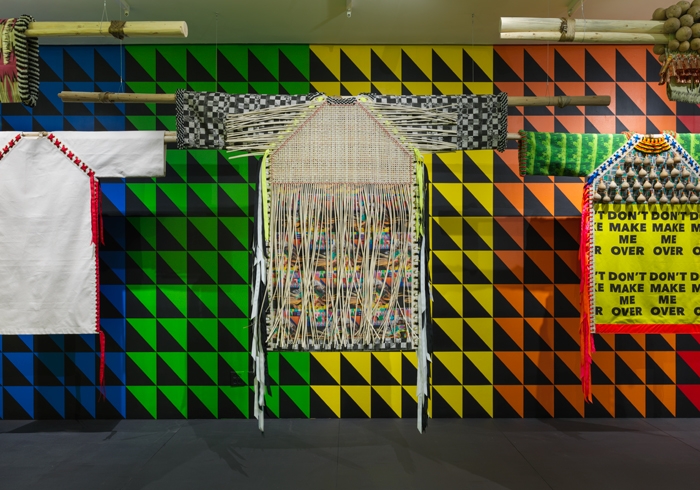Over a raised platform that curves around the L-shaped space of the New Museum’s fifth floor, backdropped by a geometric mural in neo-psychedelic colours, five ornate garments are suspended. The stitched tunics are adorned with patterned beads, quills and rattles while slogans including ‘Don’t make me over’ and ‘Stand your ground’ are printed in fluorescent letters onto their wide breasts. The stage suggests that these textiles are costumes for performance as much as artworks for display, which tallies with the literature’s description of The Anthropophagic Effect as a residency as much as an exhibition.
Part of a season investigating the theme of ‘inheritance’, Jeffrey Gibson’s engagement with the museum includes regular performances, photoshoots and lectures alongside objects produced using techniques learned over its course. The process is as much a part of the work as the product, which seems appropriate for a residency-exhibition named after a theory premised on the cannibalisation, digestion and regurgitation of colonial cultures by indigenous practitioners. Among those products are three elaborate ‘helmets’ (according to their listing in the catalogue) exhibited on shelves to one side of the hanging garments, their sweeping architectural forms built from thatched strips of split reed and artificial sinew.
That the stacked squares on which they are presented call to mind a minimalist sculpture set against a Neo-Geo wall painting is indicative of the cross-pollination of forms and traditions in Gibson’s work (a shifting soundtrack combining pipes, drums and chanting is another). Alongside the disregard for conventional disciplinary boundaries – between art and craft, artefact and artwork, exhibition and performance – this is further evidence of an attitude towards the interplay of cultures which is fluid, interlinked and fundamentally alive. Gibson identifies as Choctaw and Cherokee but, having grown up outside those communities, here expresses an idiosyncratic and richly hybridised vision that celebrates heritage while resisting strictly essentialist categorisations of culture and belonging.
Around the corner, in two vitrines, are examples of traditional indigenous handicrafts made during the residency – baskets, necklaces, moccasins and beaded belts – over which hang a small family of what look to my untrained eye like pioneer costumes: prairie dresses and brightly coloured embroidered shirts with full sleeves and frilled cuffs. The implication seems to be that these emblems of settler culture borrowed techniques from native handicrafts, and thus serve as examples of how those crafts influenced what is now misrepresented as a quintessentially white American inheritance. The work reasserts that the idea of a monolithic American culture is deliberately misleading – and that it is used to serve nefarious political ends – which isn’t to say that those cultural exchanges haven’t been predicated on violence. In her catalogue essay, Hélène Cixous draws on Shakespeare’s The Tempest – a play fraught with the issues of art and colonialism – to describe Gibson’s work as effecting a kind of transubstantiation of historical suffering into a new and visionary artform, offering a reminder that culture is at the same time something that we inherit and that we create.
These works also call to mind the double-edged insight of Virginia Woolf’s statement that it is ‘clothes that wear us and not we them’, namely that while the cultures that art and fashion express might shape our experience of the world we are also able to try them on, adjust them to fit and – if we find them constrictive – change them.
Jeffrey Gibson: The Anthropophagic Effect at New Museum, New York, 13 February – 9 June
From the April 2019 issue of ArtReview
